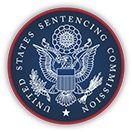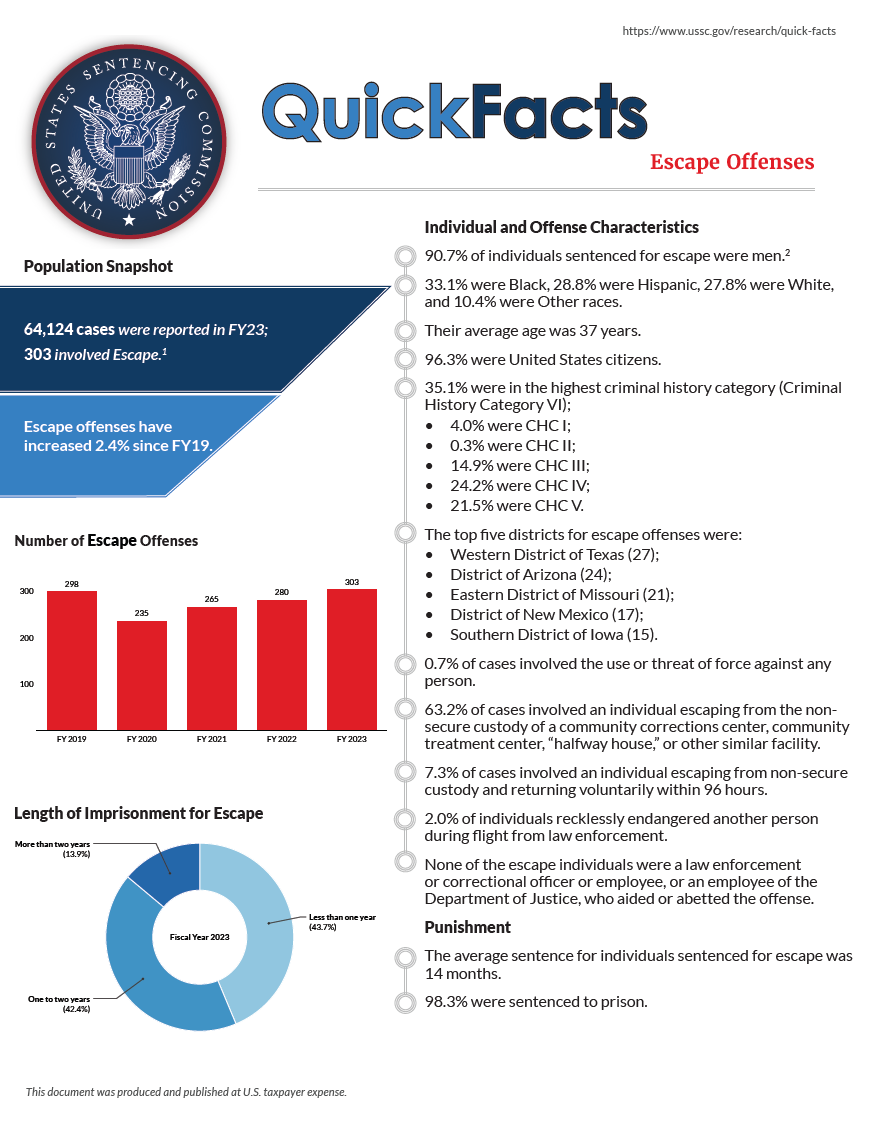Of the 61,678 cases reported to the Commission in fiscal year 2024, 287 involved escape (up 22.0% since fiscal year 2020).1,2
Click the cover for the PDF handout or learn more below.
Individual and Offense Characteristics
- 91.9% of individuals sentenced for escape were men.
- 35.4% were Hispanic, 30.2% were Black, 22.5% were White, and 11.9% were Other races.
- Their average age was 36 years.
- 97.5% were United States citizens.
- 34.7% were in the highest criminal history category (Criminal History Category VI);
- 2.5% were CHC I;
- 9.5% were CHC II;
- 20.7% were CHC III;
- 11.6% were CHC IV;
- 21.0% were CHC V.
- The top five districts for individuals sentenced for escape offenses were:
- Western District of Texas (27);
- District of Kansas (25);
- District of Arizona (18);
- Southern District of Texas (17);
- District of South Dakota (15).
- 0.7% of cases involved the use or threat of force against any person.
- 60.0% of cases involved an individual escaping from the non-secure custody of a community corrections center, community treatment center, “halfway house,” or other similar facility.
- 8.8% of cases involved an individual escaping from non-secure custody and returning voluntarily within 96 hours.
- 1.1% of individuals recklessly endangered another person during flight from law enforcement.
- None of the individuals sentenced for escape received an increase for aiding or abetting the offense while serving as a law enforcement or correctional officer or employee, or as an employee of the Department of Justice.
Punishment
- The average sentence for individuals sentenced for escape was 14 months.
- 98.9% were sentenced to prison.
Sentences Relative to the Guideline Range3
- 71.2% of sentences for escape were under the Guidelines Manual.
- 65.6% were within the guideline range.
- 1.1% were substantial assistance departures.4
- 2.8% were some other downward departure.
- The average sentence reduction was 45.4%.
- 1.4% were upward departures.
- The average sentence increase was 76.6%.
- The average sentence increase was 76.6%.
- 65.6% were within the guideline range.
- 28.8% of sentences for escape were variances.
- 23.9% were downward variances.
- The average sentence reduction was 44.5%.
- 4.9% were upward variances.
- The average sentence increase was 101.9%.
- 23.9% were downward variances.
- The average guideline minimum and average sentence imposed have remained steady over the past five years.
- The average guideline minimum was 12 months in fiscal year 2020 and 13 months in fiscal year 2024.
- The average sentence imposed was 12 months in fiscal year 2020 and 14 months in fiscal year 2024.
- The average guideline minimum was 12 months in fiscal year 2020 and 13 months in fiscal year 2024.
1 Escape offenses include cases in which the individual was sentenced under §2P1.1 (Escape, Instigating, or Assisting Escape). This offense includes failing to report to custody to serve an incarceration sentence and failing to return to custody after being released temporarily, such as for unsupervised work release.
2 Cases with incomplete sentencing information were excluded from the analysis.
3 “Early Disposition Program” (or EDP) departures are departures where the government sought a sentence below the guideline range because the defendant participated in the government’s Early Disposition Program, through which cases are resolved in an expedited manner. See USSG §5K3.1.
4 The Commission does not report the average for categories with fewer than three cases.
SOURCE: United States Sentencing Commission, FY 2020 through FY 2024 Datafiles, USSCFY20-USSCFY24.

